The Ultimate Guide to Buying Door Handles to Fit Your Home’s Style
07/11/2022, 11:40 AM


How to Choose Door Handles That Wow
Have you ever seen a doorknob you couldn’t wait to turn? Maybe it was an antique doorknob featuring an intricate design or a cool-to-the-touch nickel handle that beckoned you to enter. Door handles are an essential component of a home or business and should not be overlooked when it comes to design. Although the main purpose of a door handle is to help you enter or exit a room, it can also enhance the beauty and unity of a space.
How do you choose a door handle that complements your home’s style and offers security? We’re here to inspire you and help you make the right choice. In this ultimate guide to buying door handles, we’ll cover the following areas
We’ll cover nearly every room of the house from the bedroom to the bathroom and the many doors in between. Keep reading to learn more, or if you’re ready to shop for modern door handles for your entryway, sliding shower door or any other door in your home, browse our online store.

Chapter 1: Entry Door Handles
Can you imagine a home without door handles or knobs on the front door? You’d have to use a lot of force to push open a secure door without a knob. Lucky for us, we have these beautiful objects called doorknobs.
Doorknobs are actually not that old. Older homes dating back to the 18th century are more likely to have latch or lever hardware than knobs, regardless of style or era. Homes built in the early 18th century also featured box locks that mounted onto the surface of a door, unlike the sophisticated locks we see today.
The majority of doorknobs used during America’s early days were imported from Europe, mainly England. Early doorknobs from the 1600s were cast in brass and polished, though the cheapest knobs were made of clay. Wood and cast iron were also popular doorknob materials.
Cut glass or crystal knobs were the most expensive and became especially popular during the 1920s Art Deco movement. During the 1950s, many homeowners developed a preference for clean, straight lines and began to replace the ornate doorknobs of the earlier days with modern hardware. You can now find a vast range of luxury entry door handles, knobs and levers to suit any style.
Want to explore your options? Browse our selection of modern entry door handles or contact us today to learn more. Otherwise, keep reading to explore the variety of entryway door handles and knobs available to you.
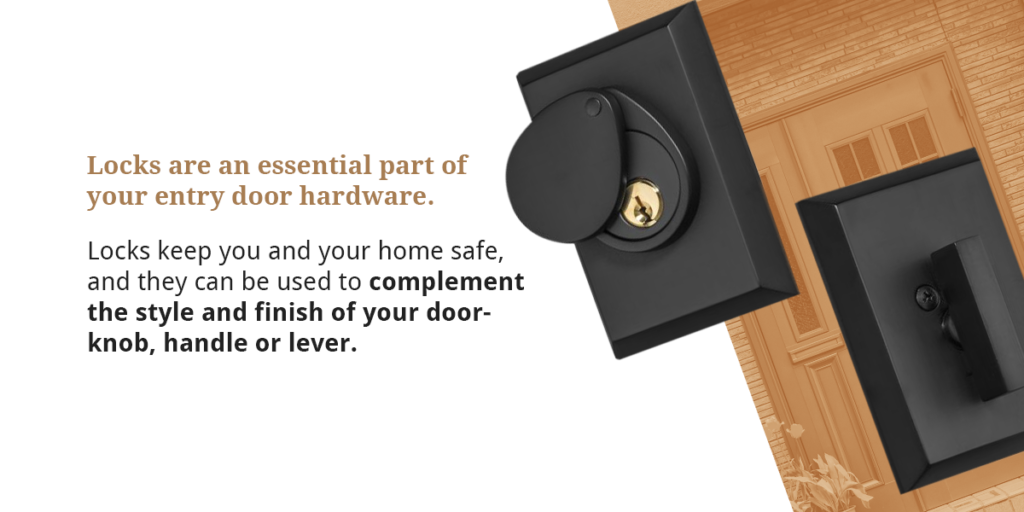
Types of Entry Doors
Before you buy a door handle for your front door, it helps to know a little bit about the different front door styles. This knowledge will help you select a doorknob or handle that suits the size and look of your entryway. Popular front door styles include:
- Traditional: Traditional doors represent the classic style you’ll find in most homes. Traditional doors usually feature raised panels, and they’re often available in wood, fiberglass and metal. You can paint a traditional door an eye-catching color and install a new handle to add instant curb appeal. Just about any style doorknob works with a traditional door.
- Craftsman: Craftsman-style entry doors are popular for many types of homes, from cottages to mountain cabins. Craftsman doors often feature straight lines and are made from wood or fiberglass. They might also feature rectangular windows or stained glass. Just like traditional doors, craftsman-style doors are highly versatile when it comes to doorknob styles.
- Modern: Modern doors offer a sleek, minimalist look and may feature frosted glass or raised panels. Modern doors are usually large and tend to have hardware that reflects the same simple style.
- Rustic: Rustic doors refer to thoseoften found in cabins or homes made of wood, stone or brick. Rustic doors might be arched or feature a traditional rectangular form, and are usually made of thick wood. These styles suggest sturdiness and might include oversized hardware.
- Arched: Arched entry doors feature acharming, curved design. Arched doors may be found in traditional, craftsman or rustic homes, and are usually custom-made to fit a home’s specifications.
What Are the Different Types of Door Handles?
Door handles are not often the center of attention when homeowners discuss curb appeal. However, the wrong knob or handle can be like wearing mismatched shoes. For example, a large contemporary door would look better with a simple yet elegant handle rather than a small gilded doorknob. In general, there are three main types of front door handles, which are:
- Doorknobs: Doorknobs are round in shape and let you enter by turning. They are the most common type of door handle. You can find just about any type of doorknob you desire from antique styles to modern looks.
- Door handles: Door handles are meant for pulling a door open. You can find entrance door handles that look fit for European castles or minimalist masterpieces.
- Door levers: Door levers are horizontal handles that allow you to push down to open a door. Like knobs and handles, these are available in a vast range of styles, from sleek and chic to handcrafted and whimsical.
What Are the Different Types of Locks?
Did you know that locking mechanisms trace back to Mesopotamia thousands of years ago? Way back then, locking systems involved a plaque, peg and hook or cord and were installed on important buildings to keep them secure. Egyptians improved the design and made keys and locks popular architectural features. Most locks we find on doors today represent the advancements made to the ancient Egyptian key-and-pin system.
Locks are an essential part of your entry door hardware. Locks keep you and your home safe, and they can be used to complement the style and finish of your doorknob, handle or lever. Here are the different types of exterior locks to help you get started:
- Deadbolts: Deadbolts usually go on exterior doors about 6 to 12 inches above the keyed entry knob, handle or lever and are used to add an extra layer of security. They are available as thumb-turn locks, single and double deadbolts. Deadbolts usually match the same material and style as the doorknob.
- Keyless: Keyless locks are modern options that require a numerical code to open the door rather than a key. For example, you might punch a code into a numerical pad on the lock when you’re ready to open the door. Keyless locks are popular choices for rental property owners because they allow guests to enter without the need for physical keys.
- Mortise locks: Mortise locksare also known as rim locks and are commonly found on commercial or glass doors. They provide a high level of security but require more skill to install because part of the door must be carved out to make room for the rectangular locking system.
Most front doors require at least a deadbolt to provide an adequate level of security. To learn more about secure, durable and stylish multi-lock systems for your front entry door, please reach out to us at Premium Hardware, where we’ll be happy to assist you.
Modern Entry Door Hardware Finishes
Though doorknobs can be made of just about any hard material, most consist of metal, such as brass, an alloy of copper and zinc. Manufacturers often apply a finish to brass hardware to protect the metal from oxidation and to achieve a particular appearance. It’s important to remember that a finish refers to the coating on a doorknob and does not describe the substrate material. Some available finishes to choose from include:
Gold-Colored Finishes
Gold-colored finishes may include polished or satin brass. A polished brass finish refers to a solid brass doorknob that had been polished to a brilliant shine. Satin brass has a smooth, matte finish that’s more subtle and less reflective than polished brass. It also has a brushed appearance. Gold-colored finishes can look beautiful on traditional entry doors.
Silver-Colored Finishes
Silver-colored finishes may include stainless steel, chrome or nickel. All of these metals may be polished or brushed. A polished finish has a bright reflective appearance, while a satin silver-colored finish has a matte, brushed look. Silver-colored hardware, particular satin finishes, look stunning with modern door styles.
Brown-Colored Finishes
If you’re looking for a brown-colored finish, you might choose bronze. A real bronze finish is typically highly polished and has a dark, iridescent look. An imitation bronze coating usually refers to any brown-colored finish made to look like bronze, but can be just as appealing.
A copper finish is another option for brown-colored hardware, which lends an antique look.
Black-Colored Finishes
You might choose a wrought iron handle for black-colored hardware that adds a ton of charm. For shiny black hardware, you might select a black japanned coating. Finally, a matte black finish is a popular metal coating for a soft yet bold look.
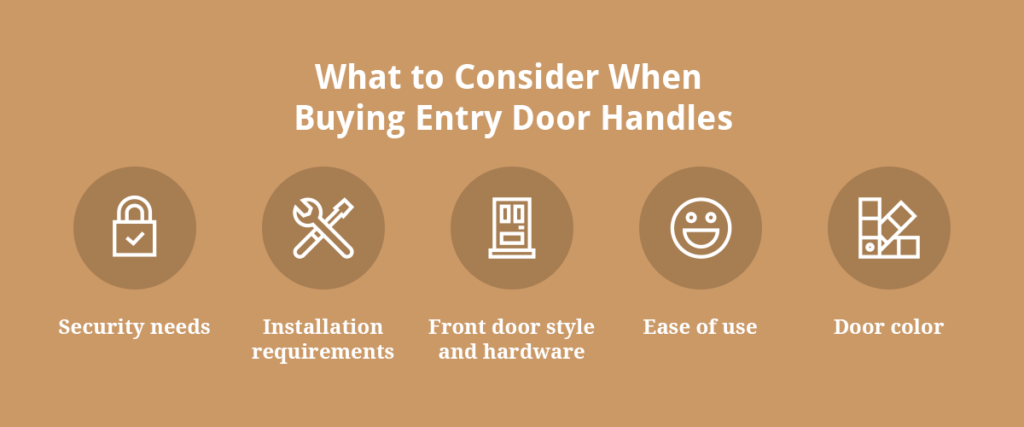
What to Consider When Buying Entry Door Handles
If you’re giving the front of your home a makeover, or if you simply need a more secure doorknob, you can’t underestimate the value of beautiful hardware. The tiny details make a great impression and help create an overall cohesive look. So, how do you choose a stylish entry door handle? Here are factors to consider as you shop:
- Security needs: You must decide how much protection you need when shopping for new door hardware. Although you want the doorknob to be visually pleasing, it won’t do much good if it can’t keep you safe. Consider where you live and the level of security you feel comfortable with. Make sure to choose something that brings you peace of mind, so that you can enjoy every moment in your sanctuary.
- Installation requirements: You’ll need to take measurements before you buy anything, or else you’ll run into installation issues. Pay special attention to the backset measurement, which is the distance from the door’s edge to the center of the handle. Also, consider the thickness of the door and the hole behind the current backplate. The key to keeping it easy is to find a handle and lockset that lines up with the existing drill holes.
- Front door style and hardware: As a general rule, try to select a handle that looks great with your door’s style and matches the already-existing hardware. For example, if your front door has silver-colored hinges, you might consider a brushed nickel doorknob. Also, think about the style of your front door. A modern door works well with clean, square-shaped styles while a rustic door is complemented by wrought iron hardware. Brass or antique finishes are beautiful with traditional doors.
- Ease of use: If you want a door that’s easy to open with an elbow as you haul bags of groceries inside, you might consider a lever. Levers are generally easier to use than knobs or handles. Keep in mind that a lever is also easier for a little one to handle, so it may not be the best option if you wish to childproof your home.
- Door color: Think about the color or material of your door when selecting a finish for your hardware. Generally, you’ll want to choose a finish that stands out against the door. So, if your front door is a deep, rich color like chocolate brown, you might consider installing brushed nickel hardware.
Benefits of Luxury Entry Door Handles
When it’s time to choose a new door handle for your front entrance, you don’t want to skimp on quality. High-quality door handles are built to offer security, safety, durability and beauty. Here are just a few more reasons to treat yourself and your guests to high-class hardware:
- Boosts curb appeal: In a well-designed home, the details matter. Anything that doesn’t suit the rest of the home’s style is bound to stand out, so it’s important to select each component thoughtfully. Adding new hardware that complements your home’s style is a way to quickly boost curb appeal for you, your visitors and potential buyers.
- Is an easy and affordable upgrade: Installing a new door handle is often an easy and affordable DIY project. You can give your entrance a whole new look with a fresh coat of paint and luxury door hardware — no major changes needed.
- Offers both protection and charm: High-quality door handles are crafted to last and keep your home protected from unwanted visitors. They are also made of attractive materials which show the world you take pride in your home. Visitors will look forward to seeing the rest of your home when they notice you put care into every detail.
Design Tips
Installing a new door handle is one way to add curb appeal to your home, and that’s something you don’t want to overlook — especially if you’re trying to sell. According to a National Association of REALTORS® study, 99% of members say curb appeal is important in attracting a buyer. You can enhance curb appeal with the following DIY tips:
- Create a well-maintained walkway that leads to your front door.
- Paint the front door a color that pops.
- Add new light fixtures and matching hardware.
- Flank the front door with pleasing-to-touch plants like ferns or soft conifers.
- Upgrade your house numbers.
You don’t have to have a huge budget to make your house look like new. For tips on how to upgrade on a budget, check out our blog.
Cleaning Tips
You only need to use a mild detergent and a damp rag to clean metal front door hardware, so avoid using abrasive materials or chemical cleaners. Make sure to lubricate locks once a year with a small amount of lubricant.
If a lock is sticky, you can squeeze a little bit of powdered graphite into the key slot and then turn the deadbolt with the key to disburse the powder. If your tarnished doorknob or handle needs a makeover, you can apply jeweler’s rouge to make it shiny again. Just make sure to keep the rouge away from the keyhole to avoid clogging the lock.
How Do You Remove a Front Door Handle?
Removing the front door handle is usually pretty simple. Here’s how:
- Take out the mounting screws that hold the interior knob to the exterior handle.
- Unscrew the faceplates on the door’s inner edge to remove the deadbolt and latch bolt.
Voila — you’re ready to install your new entry set.

Chapter 2: Interior Door Handles
Interior doorknobs are just as important as exterior handles when it comes to making an impression. They help residents and visitors feel more comfortable within a home because they add privacy to a space, and they can also tie the rooms together.
You’ll find an overwhelming amount of options as you search for interior door handles that may fit the style of your home, whether you love a sleek but bold contemporary style or a cozy and romantic French country look. In this chapter, we’ll explore the different types of door handles and factors to consider when you’re ready to shop. We’ll also provide a few practical tips to help you with your upgrade. At Premium Hardware, we offer a vast selection of high-quality, contemporary interior door handles, and we’re always happy to help you make the right choice.
What Are the Different Types of Interior Door Handles?
What type of doorknob has recently caught your attention? Did you admire the crystal cabinet knobs you saw in a friend’s kitchen? Or maybe you couldn’t resist the bright polished brass lever on the living room door? Unlike the exterior of your home, interior doors typically require a lower level of security. Therefore, you’ll have more room to be creative and focus more on aesthetic enjoyment and less on locks. Here are the various types of doorknobs you can expect to find inside a home:
- Passage knob: A passage knob is a non-locking doorknob which might be used anywhere privacy is not a concern. For example, you might find passage knobs on closet doors or entrances to rooms. You can select non-locking handles for a formal look, or levers for easy use.
- Dummy knob: Dummy knobs do not lock or turn at all. These types of knobs are common on closets, pantry or utility space doors, or basically any door that does not require a latch. Dummy knobs are fun to use as decorative touches.
- Half dummy: Half dummy handles or doorknobs refer to those that function as pulls and which do not actually turn. They may be used on double doors with top latches or French doors with only one functional door, for example.
- Privacy knob: Privacy knobs can be locked, usually by pushing or turning a button in the center of the knob. Privacy knobs are generally used in bedrooms and bathrooms. You might also choose from a range of privacy levers to suit your style.
- Pocket door handle: A pocket door handle is a recessed insert with a door pull, suitable for pocket doors. Pocket doors are common in older homes and slide into the wall when they’re open.
What to Consider When Buying Interior Doorknobs
When you’re shopping for interior door handles, you’ll generally want to focus on function, style and the level of privacy you need. Here are all of the top factors you’ll want to consider when searching for your new interior door hardware:
- Measurements and installation: Make sure to take the right measurements before you buy new doorknobs. Measure the backset, the thickness of the door and the hole where the latch goes. If you’re buying dummy knobs, you don’t have to worry about measurements as much. Dummy knobs mount to the surface of a door with screws and do not use latches or locking mechanisms. Don’t forget to think about ease of installation, and whether or not it’s a DIY project you can handle or one that needs professional assistance.
- Privacy: Ask yourself how much privacy you need to feel comfortable in a room. For example, is it acceptable to have a lock that can easily be unlocked from the outside on your bedroom door or do you want something more secure? Or maybe you prefer a doorknob that’s easy to open with a coin in an emergency. Think about everyone who uses the room that will be getting a new doorknob.
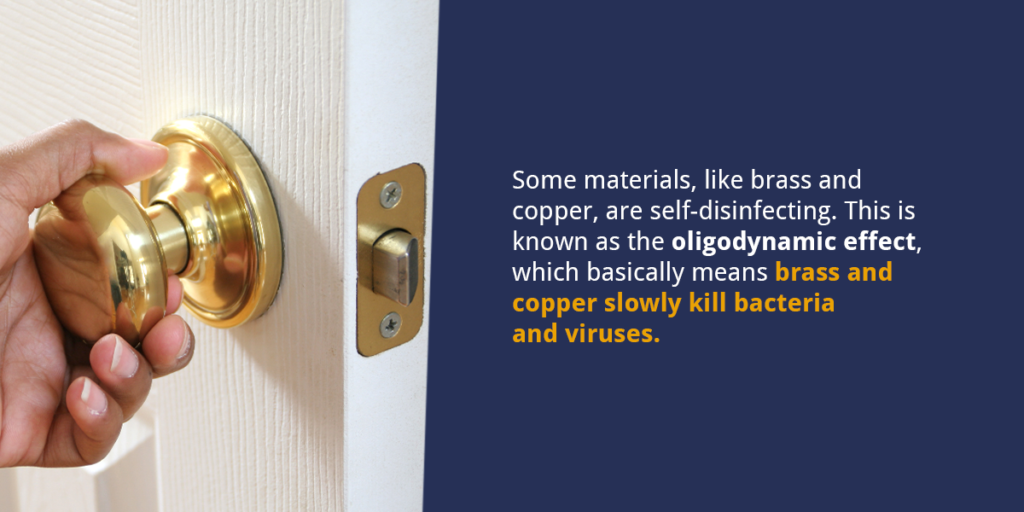
- Function: Consider choosing a doorknob or lever that makes your life easier. For example, if you need a new doorknob in your bathroom or kitchen, you may want to select a finish that’s easy to clean or resistant to germs. Some materials, like brass and copper, are self-disinfecting. This is known as the oligodynamic effect, which basically means brass and copper slowly kill bacteria and viruses. Also, you might choose hardware that’s easy for children or individuals with arthritis to use, such as a lever.
- Style and shape: Doorknobs come in many different forms, such as round, octagon, egg and ball shapes. Levers may be slim and flat or smooth and curved. Consider the shapes surrounding the door to help you create a balanced look and make a room more interesting. Also, think about the style of the room and the look you want to create. Typically, sleek handles complement a modern look, while curved levers may be perfect for a traditional style. Simple, round doorknobs go with just about any type of room.
- Finish: Consider how the doorknob’s finish will work with other elements and metals used in the room. While all the doorknobs in your house do not have to match perfectly, you’ll at least want to make sure all the doorknobs in a room have the same color and finish. You’ll also want to think about your style when selecting the finish. For example, dark bronze hardware highlights an industrial style, while polished brass creates a vintage feel. Lastly, aim to choose a finish in a color that stands out from the door.
Benefits of an Interior Doorknob Upgrade
There are plenty of reasons to upgrade your door hardware within your home, such as:
- Helps complete a room: Door hardware helps tie all of the elements in a room together for a completely satisfying look. Even if you have an eclectic style and enjoy collecting objects from around the world, your door hardware can help bring every unique piece together to make a room feel more relaxed.
- Makes it easy to add style: Installing new doorknobs or levers is an easy, nearly instant way to add style to any room. You don’t have to be an experienced carpenter or seasoned painter to make a room feel fresh by adding new accessories like beautiful door hardware. For example, if you want to make a room feel more minimalist, a simple doorknob with a matte black finish will do the job.
- Increases privacy: Privacy equals comfort in bedrooms and bathrooms, as no one enjoys a surprise walk-in. If you’ve been longing to make your personal haven feel more secure, why wait any longer? Treat yourself to a privacy knob or lever with a locking function to help create a more comfortable space.
- Is an affordable way to add quality details: Some decorative details are expensive — think fine art or an elaborate chandelier. You don’t need to spend thousands of dollars to make your home look and feel more luxurious. You can find new, high-quality door hardware to suit a range of budgets. As interior designers know, replacing old hardware with new pieces is an age-old trick for getting a new look without breaking the bank.
- Adds texture to a room: Texture is used to describe how something feels — or how it appears to feel. Though texture is often overlooked, it has great potential to add depth and visual interest to a room. You can effortlessly add texture with a new doorknob. For example, a glossy door becomes much more intriguing if you install a brushed nickel doorknob rather than a shiny handle. Adding a mix of textures is especially useful to keep a neutral room from feeling blah.
- Increases the functionality of a door: The wrong doorknob can make it challenging to open a door under certain circumstances. For example, did you ever try to turn a polished brass doorknob with cold hands? It may have been hard to get a grip. If you choose a new doorknob with functionality in mind, you can make your life a little easier and put less stress on the door itself.
Design Tips
Do you feel inspired to give a room in your home a whole new look and atmosphere? Here are some tips to help you incorporate your new door hardware into a breathtaking design:
- Consider all the metals in the room: As we mentioned above, you don’t need every piece of hardware in your home to match. However, it’s generally best to stick to the same metals within each room itself, which may include lamp bases and drawer pulls. If you want to play around with contrasting metals and colors, try to use similar tones. It’s recommended to match metals in kitchens and bathrooms, where they may be more of a focus.
- Upgrade the light switch plates: How often do you think about light switches even though you likely use them several times a day? Consider upgrading your light switch plates when you replace your doorknobs and choose a similar finish.
- Apply fresh paint: If you want to take a room makeover to the next level, consider giving the walls or doors a fresh coat of paint. Painting a room is another generally low-cost way to make a space look completely different. If you want to draw attention to the walls, don’t be afraid to choose a vibrant color you love. If you prefer to fill a room with bright, bold furniture, consider selecting a neutral shade for the walls.
- Go with your instinct: Lastly, follow your instinct when choosing new door hardware or any accessories for your home. If something makes you feel joy, you know it’s the right choice.
Cleaning Tips
Cleaning your doorknobs or handles doesn’t have to be a time-consuming task, but should be part of your regular routine to minimize germs and keep metal sparkling. Warm, soapy water and a clean rag will do the trick for cleaning metals like stainless steel, brushed nickel or brass. After cleaning doorknobs with soapy water, rinse them to remove any residue and dry them with a clean cloth.
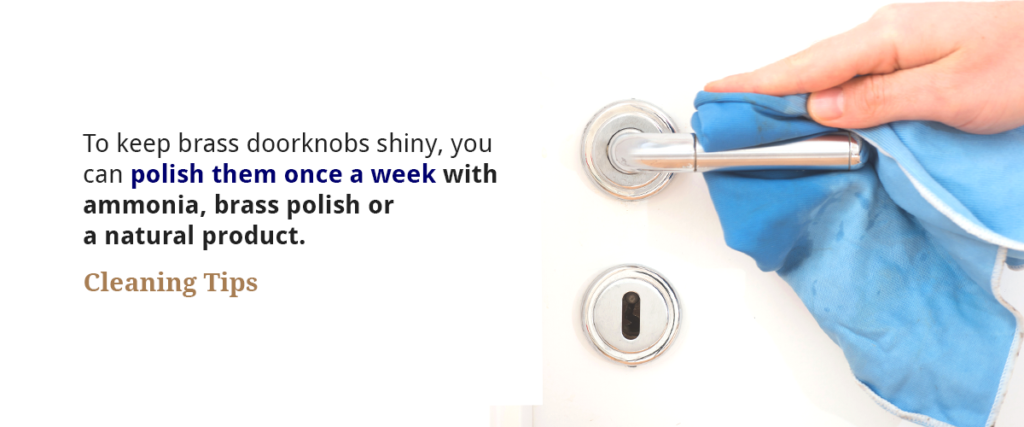
To keep brass doorknobs shiny, you can polish them once a week with ammonia, brass polish or a natural product. Just make sure to protect other parts of the door with painter’s tape while polishing.
Don’t forget to clean the doors while you’re at it. To clean your doors, wipe them down with a paper towel first to remove loose dirt and dust, then apply a mix of dish soap and water. Dry them with a paper towel.
How Do You Install a Lock on a Bedroom Door?
If a bedroom doorknob has a lock, it’s usually a thumb lock, which may be a push-button on the knob or handle or a small lever in the middle. Interior doorknobs also often have a slot or a small hole on the other side, which can easily be unlocked with a coin or piece of metal.
Rather than install a deadbolt or a keyed entry knob, you can mount a surface bolt to the inside of the door. A surface bolt, such as a sliding bolt, cannot be unlocked from the outside. And, it’s relatively easy to install with a few basic tools. Here’s how to install a surface bolt:
- Place the bolt on the door to make sure it’s level with the edge of the door and mark the screw holes with a pencil.
- Drill a 1/8-inch hole into each mark — the depth of the holes should be equal to about half the length of each screw.
- Align the lock with the holes and screw it into place.
- Close the door and extend the lock — mark its position.
- Drill pilot holes for the catch.
- Install the catch.
Make sure to install the bolt at a height that’s easy for you to reach, typically a foot or two above the knob.
How Do You Remove a Bedroom Doorknob That Has No Screws?
Modern bedroom door hardware may not display screws. You can still remove the doorknob, but you have to know where to look. First, open the door and look for a slot or a hex-head set screw on the lock side of the doorknob. Use a hex-head wrench to turn the set screw until the doorknob loosens, or if it’s a thin slot, use a flathead screwdriver. Pull the knob away from the doorknob body. Use a Phillips screwdriver to undo the screws holding the knob body to the door.
You might have a doorknob that’s released by a latch. If this is the case, search for a small hole or indent in the stem, or the portion between the turning piece and the backplate. The latch might also be located on the knob itself. After you find the latch, push it in with a screwdriver and remove the knob with your hand. You should then be able to access the internal screws.

Chapter 3: Sliding Door Handles
Did you know that sliding doors go back as far as ancient Rome? You will find ruins of a sliding door track in Pompeii, but they may have existed even before then. It’s easy to see why these types of doors were used even back in ancient times. One of the main features of sliding doors is they don’t take up any floor space, so you have much more room to mingle or add your favorite piece of decor — like that fiddle leaf fig tree you just have to have.
Here’s how it works: A sliding door opens horizontally and may be mounted above or below a track. Some sliding doors “disappear” into the wall. They’re typically composed of large glass panels to create a wide-open feeling and flood the space with natural light. Depending on the type of sliding door you have, one panel may stay in a fixed position while the other one slides open. You’ll often find sliding doors opening up to patios, balconies or backyards. They are also commonly used as shower doors.
If you’re ready for a new and impressive upgrade, you’ll find a wide selection of premium sliding door handles to choose from. Let’s look at the different types of handles to help you make the right choice. If you have any questions or concerns along the way, reach out to us at Premium Hardware.
Types of Sliding Door Handles
Sliding doors typically use handles rather than knobs or levers. Handles help you form a firm grip so you can easily slide the door open along its track. At Premium Hardware, we offer sliding door handles in round, square and other shapes with finishes ranging from bright polished brass to rich Tuscan bronze. Here are some of the different types of sliding door handles you can expect to find:
- Surface mount handles: Surface mount handles are usually installed on the surface of the door. The handle might have a clamp or hook built into it, which latches onto the door frame.
- Mortise lock handle sets: With mortise style sets, the lock and the handle are separate. The mortise lock fits inside the door panel and is operated by a thumb latch that’s located on the handle backplate.
- Inset style locksets: Inset style locksets combine the handle and lock in a single unit and lay flush with the door. These types of handles are commonly seen with aluminum sliding doors.
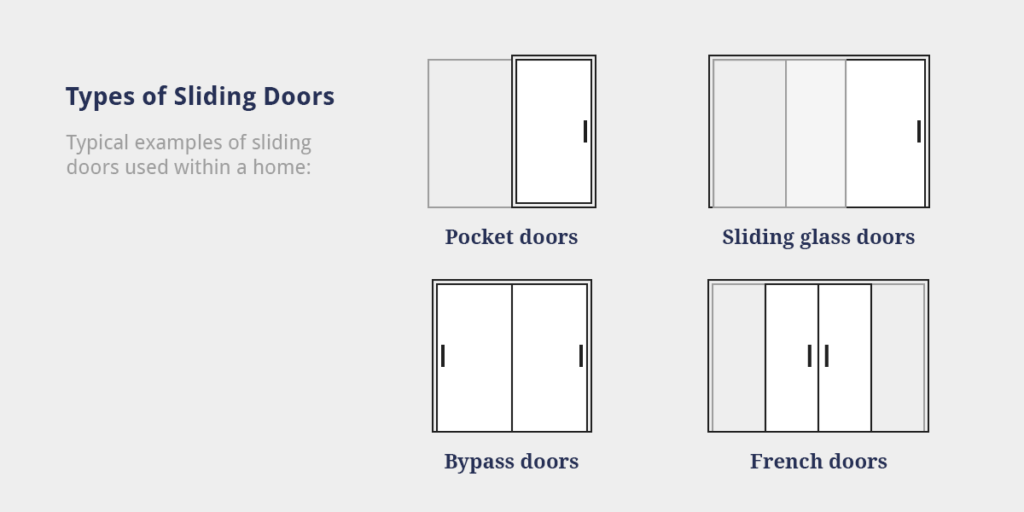
Types of Sliding Doors
You’ll need to consider the type of sliding door you have to choose a handle that’ll function as it should. Here are typical examples of sliding doors used within a home:
- Pocket doors: Pocket doors run along a track and go into a wall compartment. They are often used where there is not enough room for a hinged door. Pocket doors typically have recessed inserts rather than handles.
- Sliding glass doors: Sliding glass doors are usually rectangular in shape and commonly found as patio doors. A sliding glass door requires sturdy handles to withstand wear and tear and help the users open it with ease.
- Bypass doors: Bypass doors slide past each other to open, and are often used as closet doors. Like pocket doors, bypass doors typically use flush pulls or recessed inserts.
- French doors: Though French doors usually swing open, modern variations slide to save space. Just like regular French doors, you’ll want to choose handles that match, but which are suitable for a sliding motion.
Factors to Consider When Buying Sliding Door Handles
Sliding door handles require special consideration. First, think about where your sliding door is located. If you’re like many homeowners, your sliding door leads to the backyard or patio. This means it may get a lot of use during the summer when guests may enter and exit your home frequently, and you’ll need sturdy handles that are easy to operate. There are many things to consider when choosing a sliding patio door handle, such as:
- Home’s exterior and interior style: Since sliding doors typically open to the backyard, it helps to consider the exterior style of your home as well as the interior when choosing new handles. For example, if your home is modern inside and out, consider selecting sleek brushed-metal handles to match your overall look.
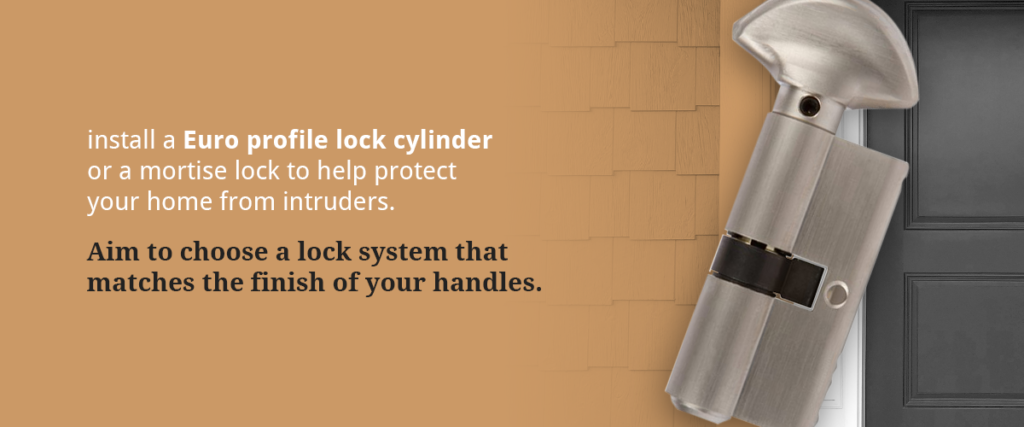
- Security needs: If your sliding door leads to the outside of your home, you’ll want it to be just as secure as the front door. Therefore, it’s crucial to choose a handle that locks securely. You might install a Euro profile lock cylinder or a mortise lock to help protect your home from intruders. Aim to choose a lock system that matches the finish of your handles.
- Functionality: How many times have you tried pushing a stubborn patio door open with a plate of burgers in one hand and a bowl of salad in the other? Consider handles that are easy to grip or push to make those special occasions, or any occasion, a little more pleasant.
- Childproofing requirements: If you have little ones at home, consider how childproof you want your sliding door to be, especially if it leads to the backyard. While there are devices you can install to childproof a sliding door, such as a plastic lock that fits into the door frame, you might consider purchasing a handle with a reliable lock that little fingers can’t reach.
Benefits of a Quality Sliding Door Handle
Sliding doors handles are usually not something you want to skimp on when it comes to quality. As you browse, you’ll find that high-quality handles do not cost too much more than cheaper-made ones. Here’s why it’s worth it to buy superior handles:
- Increases security: You most likely wouldn’t install a plastic door handle on your front door for security reasons. The same rule should apply to the back, especially since it’s one of your home’s weak spots. According to an article by the International Association of Certified Home Inspectors, 22% of burglars enter through the back door, and 4% get in through any unlocked entrance. Therefore, if the sliding door in your home also functions as an entrance, it’s well worth investing in quality hardware.
- Adds beauty to your backyard: Your home’s beauty is not all about curb appeal or what can be seen from the road — your backyard makes an impact too, especially if you’re trying to sell. According to the National Association of REALTORS®, outdoor features like a new patio rank among the top projects most likely to add value to a home and appeal to buyers. New hardware is one detail that can make a big difference.
- Makes it easy to get a grip: You and your guests shouldn’t have to struggle to open a sliding door, or feel like the handle is going to snap off if you push too hard. Although it’s important to keep the track clean and the rollers in working condition, a quality handle helps a door glide open like it should.
- Easy to clean: Sliding door handles can get messy. Think barbecue sauce, dirt and other debris. A smooth metal handle is easy to wipe down with a little soapy water and will look just as clean as it feels.
- Durable: A sliding door handle needs to be able to withstand a lot of pulling and pushing action. Choosing a quality, durable handle keeps you from having to replace the handle, or door, sooner than you need to.
Sliding Door Tips
Sliding doors are attractive space-saving alternatives to traditional hinged doors, and there’s a lot to appreciate about them. Here are some tips to help you enjoy your home’s sliding doors even more.
Increase Security
As we mentioned, it’s critical to address the security of your sliding door if it leads to the outside of your home. Adding a sturdy lock and handle surely helps keep out intruders, but there are other steps you can take to increase security, such as:
- Install a bar to prevent sliding: If you’re heading out of town or won’t be using your sliding door for a while, consider placing a bar in the track of the door. This will keep the door from sliding open even if a burglar damages the lock.
- Include it in your alarm system: If you have an alarm system at home, make sure it’s connected to your sliding door. You can also install sensors to alert you if a burglar tries to smash the glass.
- Hang curtains: Consider hanging drapes over your sliding door or installing shades, if you don’t have them already. Close the curtain when you’re not in the room to keep outsiders from looking in.
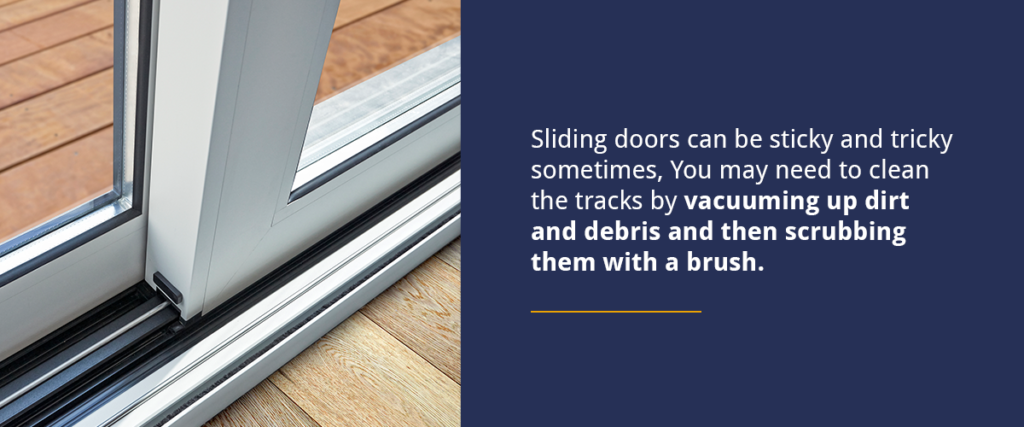
Make It Easier to Slide
Sliding doors can be sticky and tricky sometimes, but there are ways to get them to glide like new. You may need to clean the tracks by vacuuming up dirt and debris and then scrubbing them with a brush. Vacuum again once you loosen up the stuck dirt and wipe it clean with a damp sponge. After you’ve cleaned the tracks, spray them with a silicone-based lubricant. If those steps do not work, you may need to adjust the rollers or remove them for a more thorough cleaning.
How Do You Replace a Sliding Door Handle?
You can replace contemporary patio door handles easily and quickly if you plan to change them out with similar handles. If you choose a different type of handle for your door, you may need to drill new holes. Generally, to replace a sliding door handle, you’ll only need to take these steps:
- Take off the old handles by removing the screws.
- Take measurements to help you choose new handles.
- Screw the new handles into the door and drill new holes if needed.
How Do You Fix a Sliding Door Latch?
It’s important to make sure the latch works correctly, and if it doesn’t, it’s a quick and easy fix. Here’s an overview of how to replace a latch on a sliding door:
- Check the latch to see if it’s broken or simply needs some lubricant.
- If lubricating doesn’t work, the latch likely needs to be replaced.
- First, remove the screws in the handle so you can slide the latch lever out of place.
- Insert a graphite pen into the lowest screw hole to keep the latch from falling into the frame.
- Unscrew the lock mounting screws and use pliers to pull the body out of the door.
- Use the old latch to help you choose a new one of the right size.
- Fit the new latch in the correct space and tighten the mounting screws.
- After you install the new latch, test it to ensure it works correctly.
Can You Put a Key Lock on a Sliding Glass Door?
Sliding glass doors are usually only lockable from the inside, but you can use it as an entry point if you wish. You can add a key lock inside or outside the door for greater security. Some handles have key locks built into them but may require a mortise lock installed into the frame.
Before you add any new lock or handle to your sliding glass door, make sure to clean the frame with warm, soapy water and let it dry first. Also, tap the frame with the end of a screwdriver until you hear a sound change to ensure you don’t drill holes where there’s glass.

Chapter 4: Shower Door Handles
Is your bathroom your favorite room in the house? If you love spending time unwinding in your bathroom and dream of an upgrade, you’re not alone. According to a recent survey, 27% of Americans would spend money renovating their master bath if they could. Fortunately, you don’t have to spend a ton to make a bathroom look and feel like new. Upgrading your sliding shower door handle is one way to add luxurious detail to a spa-like sanctuary. In this chapter, we’ll help you choose a shower door handle to create the look you want.
Types of Shower Door Handles
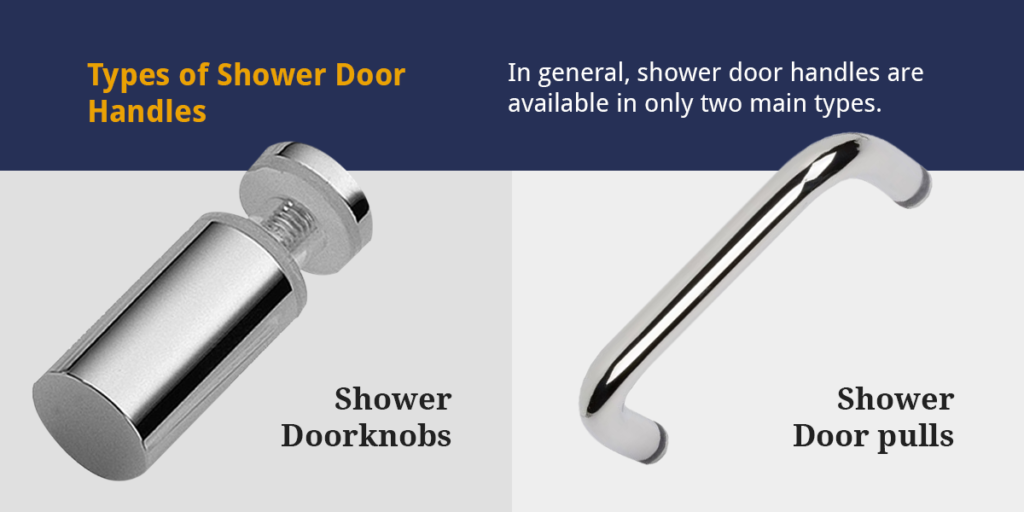
In general, shower door handles are available in only two main types. These include:
- Shower doorknobs: Shower doorknobs are sleek and minimalist. They may be cylindrical shaped or round like a traditional doorknob and may be perfect for a frameless glass door. Unlike regular doorknobs, shower doorknobs simply screw into place and do not involve any sort of latching or locking mechanisms.
- Shower door pulls: You can choose from a range of modern shower door pull handles, ideal for heavy glass doors. Or, if you have a sliding glass door, you might opt for barely-there finger pulls to keep your shower as visually open as possible.
Types of Shower Doors
Consider the type of shower door you have to choose the right handle, pull or knob. Here are common types of shower doors:
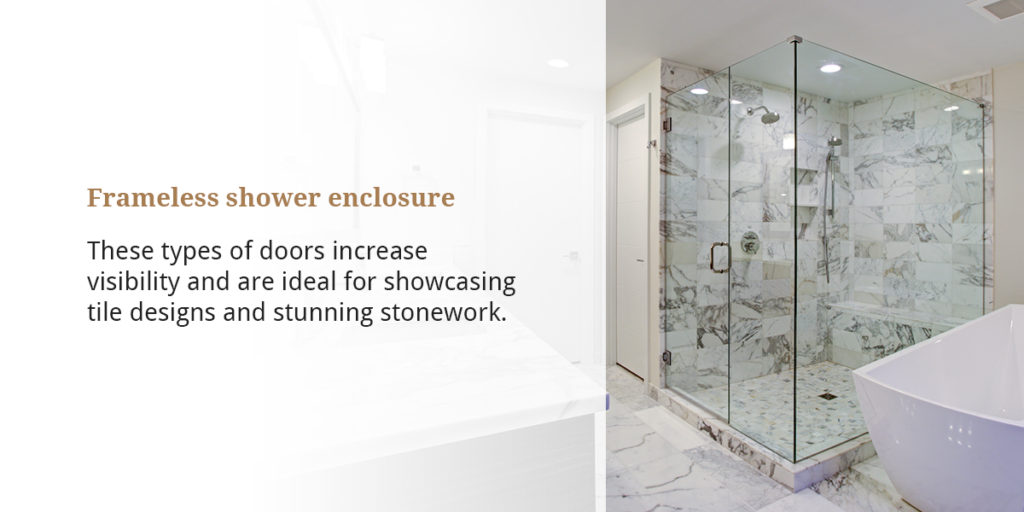
- Frameless shower enclosure: A frameless shower enclosure uses sturdy tempered glass that does not require a metal frame around the edges. These types of doors increase visibility and are ideal for showcasing tile designs and stunning stonework.
- Semi-frameless shower doors: Semi-frameless shower doors offer a contemporary style as an alternative to a frameless enclosure. These types of doors have a metal frame around the whole structure, but not the entire door.
- Framed shower doors: Framed shower doors are a sturdy and affordable option. Framed shower doors are typically surrounded by an aluminum frame, which may be coated in chrome, nickel, bronze or another type of metal.
Either framed or frameless doors may function in the following ways:
- Slide: Sliding doors often make a practical choice for narrow bathrooms. Sliding doors are usually adorned with a sturdy horizontal or vertical bar-shaped handle, though they can be fitted with finger pulls or doorknobs.
- Pivot: Pivoting shower doors open like traditional hinged doors. These require handles that make it easy to get a good grip and pull a door open.
Factors to Consider When Shopping for Shower Door Handles
Shower door handles are designed to fit seamlessly into a bathroom’s overall style and typically feature a simple design. They must also allow the user to open and close the shower door easily. With the following factors in mind, it shouldn’t be too challenging to find a new shower door pull, handle or doorknob that adds a dazzling touch:
- Finish of bathroom hardware and fixtures: You can create a stunning bathroom by merely choosing a shower door handle that matches the other fixtures and hardware in the bathroom. For example, if your sink features a polished chrome faucet, you can’t go wrong by adding the same finish for your shower handle. If possible, upgrade drawer pulls and the doorknob in the same finish or color to tie the room together.
- Shower tile and wall colors: Also, take notice of the tiles and the wall color in your bathroom to help you select hardware that enables you to achieve the look you want. If you want the metal features in your bathroom to stand out, consider darker finishes like bronze or a matte black coating. If you want a sparklingly clean look that goes with just about any color scheme, consider polished nickel or chrome. For a vintage touch, you might go with polished or satin brass.
- Ease of use: Try to choose a door handle that’s easy for you to use, especially with wet hands. If you have a pivoting shower door that tends to get stuck, for example, make sure to choose a sturdy handle that allows you to get a good grip.
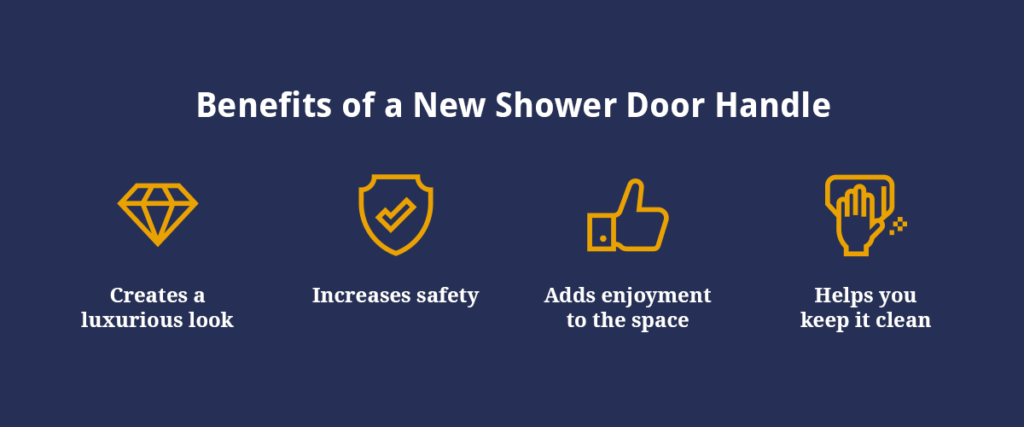
Benefits of a New Shower Door Handle
Still not sure if a new shower handle’s worth installing? Consider the following benefits to help you decide:
- Creates a luxurious look: Matching hardware in a bathroom instantly creates a sense of luxury. Plus, shower door handles are relatively easy to install. So, for little cost and little time, you can give your bathroom a quick makeover.
- Increases safety: Bathroom and shower floors can get slippery pretty fast. A new high-quality door handle helps you get a better grip to make it easier to get in and out of the shower.
- Adds enjoyment to the space: If you enjoy relaxing in the shower or tub, a new handle can make a difference in adding comfort to your sanctuary. Small details make a bigger impact than we realize sometimes. When you add a new handle in a beautiful finish that complements your space, you’ll notice the difference right away.
- Helps you keep it clean: A new shower handle can be easier to sanitize than an old handle, depending on the material you choose. Remember how we talked about the oligodynamic effect in Chapter Two? Copper and brass are naturally self-cleaning, so you can help keep a bathroom germ-free with those types of metals. If you prefer a high-shine, polished chrome or nickel make a bathroom sparkle after a quick wipe down.
Design Tips
Adding a new shower handle is just part of creating a radiant bathroom. Here are a few more tips from the pros to help you bring it all together:
- Choose handles that match the metal of all bathroom fixtures for a cohesive look.
- Create an overall luxury bathroom with a new showerhead.
- Reduce visual clutter by installing a clear shower enclosure and contemporary handles
- Replace a curtain with a glass door to open up the room.
- Avoid busy details — after all, the bathroom can be a place to relax.
- Emphasize texture rather than color to add interest and keep the space feeling calm.
Cleaning Tips
A clean bathroom is a comfortable and happy bathroom. With a new shower door handle in place and everything else looking great, use these tips to help you keep it fresh, clean and beautiful:
- Clean glass shower doors with white vinegar to remove soap scum.
- Wipe your shower down after each use to limit soap scum buildup.
- Use an old toothbrush and dish soap to remove grime.
- Only use water to clean oil-rubbed bronze or brass finishes.
- Use water, mild dish soap and a microfiber cloth to clean chrome.

Chapter 5: Door Hardware
Door hardware refers to the components that attach to a door and includes handles, locks, hinges and any accessories such as door knockers or peepholes. Door hardware is used to improve functionality and style.
Today’s home and business owners enjoy an endless array of hardware items, from antique door knockers to contemporary door hardware. We’ll explore door hardware in this final chapter and provide helpful tips. If you’re ready to shop for luxury door hardware now, check out our inventory at Premium Hardware.
What Is the Most Popular Finish for Door Hardware?
According to interior design experts, aged brass and matte black hardware are popular choices for modern styles. In general, satin and antique finishes are common looks that aren’t likely to go away anytime soon. Customized hardware is also a popular option for many homeowners who want to personalize every detail of their home. Regardless of the current fashion, it’s most important to go with a finish that feels right. For example, ask yourself what you like better — shiny and smooth or dark and textured?
How to Tell It’s Time to Replace Hardware
If you’re not sure if it’s time to replace hardware or doorknobs, there are few ways to tell, such as:
- Your door no longer works the way it should.
- Pieces of hardware are missing or broken.
- The lock is stiff.
- You’re using the wrong grade of hardware on the door.
- The doorknob is loose in the door.
Hardware Cleaning Tips
You can refurbish old hardware by carefully removing it and applying an effective metal cleaner or a simple mix of baking soda and vinegar. Just make sure to determine the type of metal you have before using a cleaning product to prevent damage to the finish and to ensure you can clean it effectively.
If hardware squeaks, a little lubrication is usually all you need to make it quiet again. Graphite powder is the preferred lubricant for door locks, and candle wax is ideal for lubricating hinge pins.
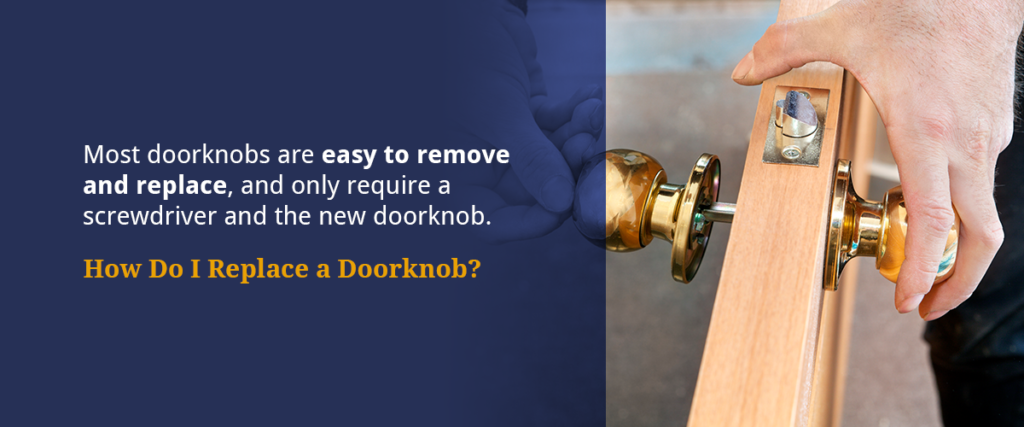
How Do I Replace a Doorknob?
Most doorknobs are easy to remove and replace, and only require a screwdriver and the new doorknob. Depending on the replacement handle, you may also need a drill. No matter which type of replacement doorknob you choose, you’ll generally take these steps:
- Remove the old doorknob with a screwdriver and pull out the latch.
- Remove the old strike plate from the door frame.
- Measure the backset to ensure you buy a doorknob that will fit correctly.
- Install the new latch and attach the knob.
- Lastly, attach the new strike plate.
Where Are the Parts of a Doorknob?
Knowing some doorknob terminology can help you choose and install the correct components. Here are a few doorknob-related terms to keep in your toolbox:
- Backplate: A decorative plate that goes between the knob and the door.
- Bolting mechanism: The piece which extends from the middle of the doorknob into the latch hole.
- Faceplate: The small metal plate that surrounds the latch on the edge of the door.
- Hardware: Refers to the screws and other metal pieces that help hold the doorknob in place.
- Latch: The part of the lock that extends into the door frame through the strike plate and keeps the door closed.
- Lock cylinder: The piece that contains the “code” for the key.
- Rosette: A decorative plate that goes between the knob and the door but which is smaller than a backplate.
- Strike plate: The thin piece of metal installed on the door frame that surrounds the latch hole.
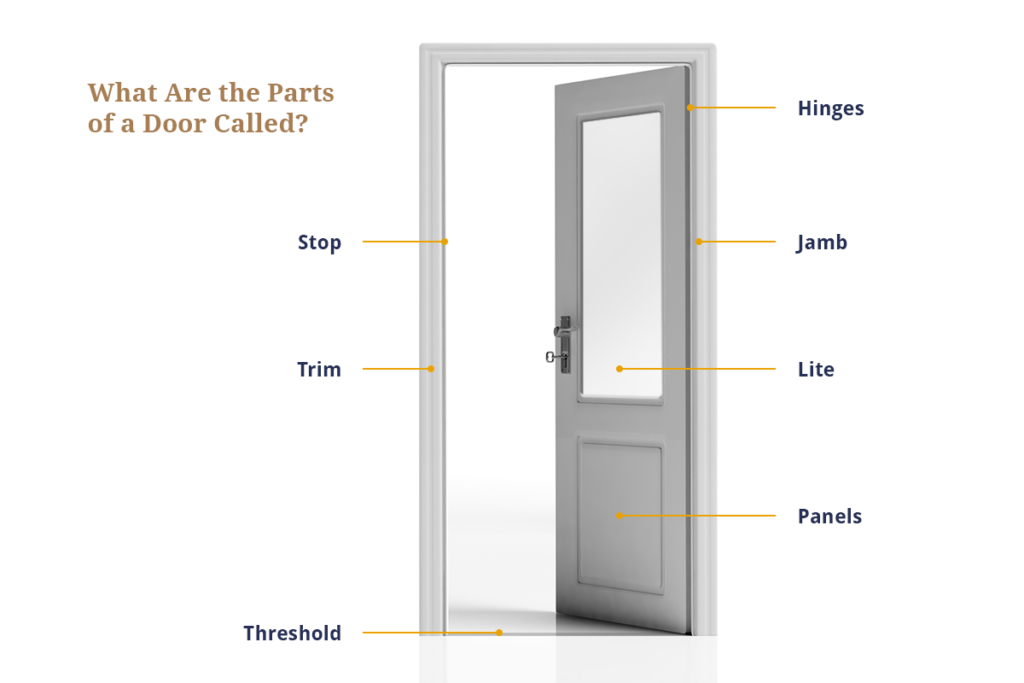
What Are the Parts of a Door Called?
Lastly, knowing the parts of a door can also help you through the shopping and installation process. Door parts include:
- Hinges: Movable mechanisms that allow the door to open and close.
- Jamb: The vertical part of the frame where the hinges are located.
- Lite: A window or glass panel in a door.
- Panels: Decorative recessed or flat sections.
- Stops: The wood or metal that runs up the frame and keeps the door from swinging open farther.
- Threshold: The part that crosses underneath the bottom of the door.
- Trim: The woodwork around the door frame.
How Do I Know What Size Doorknob to Buy?
Finding a right-sized doorknob usually requires two steps, which are:
- Measure from the center of the doorknob hole to the edge of the doorway.
- Find a doorknob or handle that fits comfortably in your hands.
If you’re not sure, you can always use the old doorknob as a guide, or reach out to us at Premium Hardware for expert assistance.
Beautify Your Door With Premium Hardware

Next time you open or close a door, pause for a moment to notice the handle. How does it feel? How does it turn? Does it enhance the beauty of the door? Interior designers know that magic lies within the details. Your door hardware is worth the extra attention. Especially since it’s one of the first elements a visitor will see.
Choose door hardware that complements your home’s style and personality, and you’ll appreciate the upgrade right away. At Premium Hardware, we’re ready to help you select a door handle you’ll enjoy. We specialize in designing and manufacturing luxury door hardware that’s elegant, durable and safe. Browse our products to buy stylish and secure contemporary door hardware, or contact us today to learn more.
